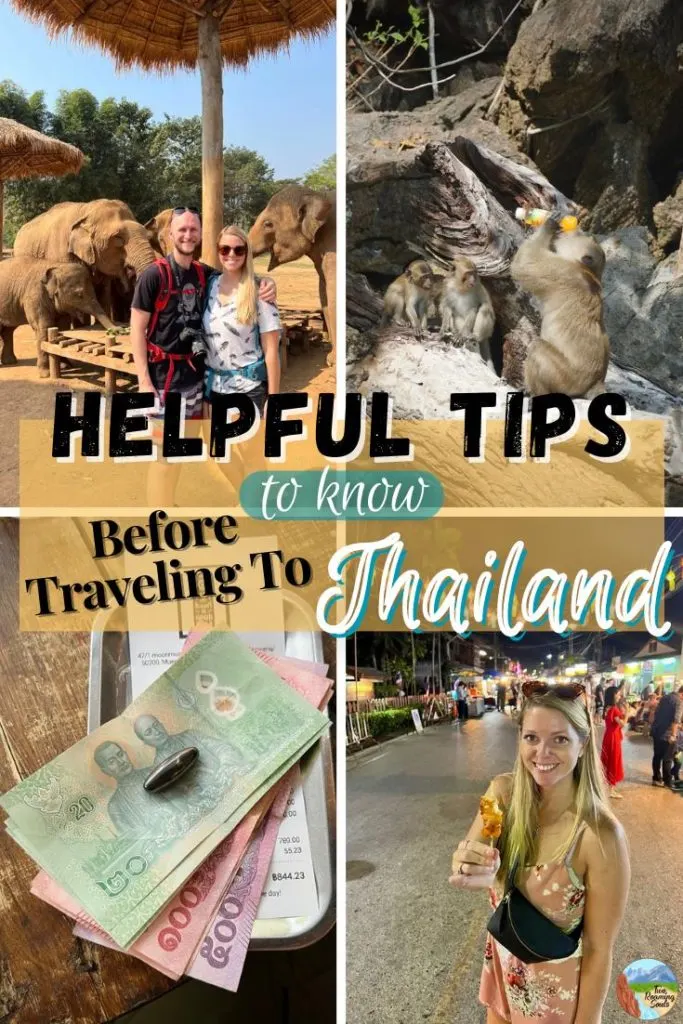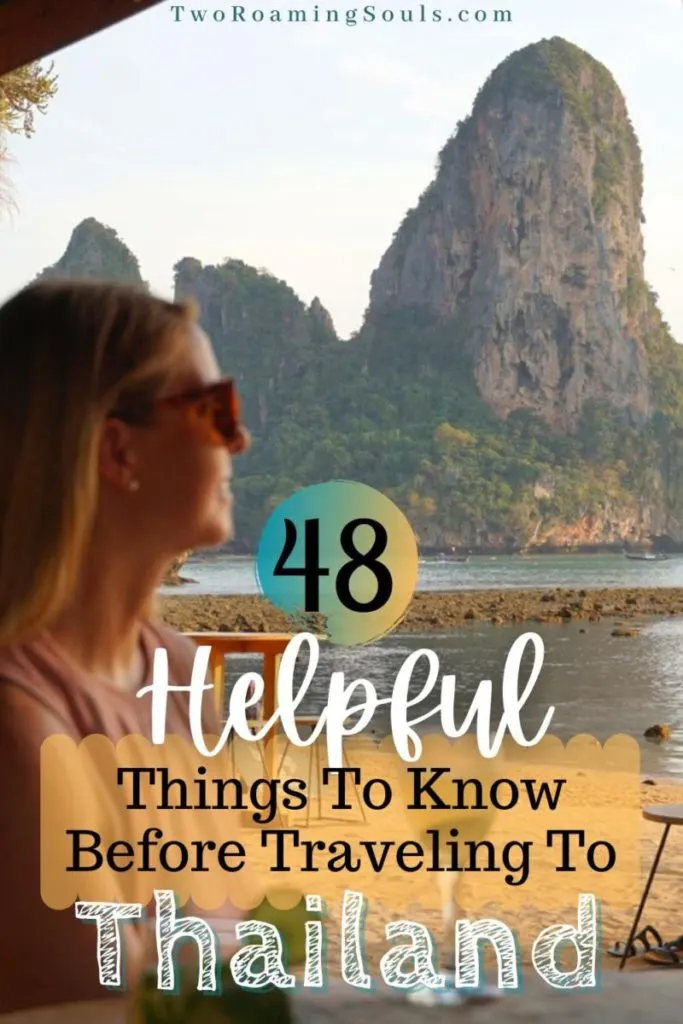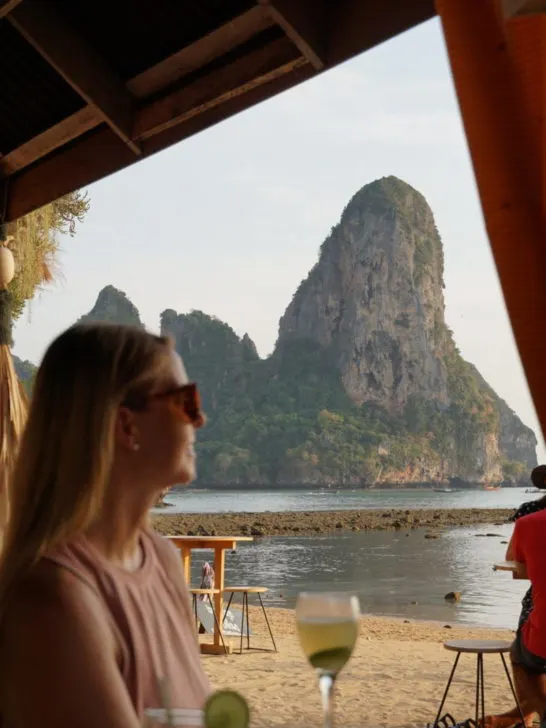
Traveling to Thailand can be an incredibly enriching experience. However, for first-time travelers, it may also be quite intimidating. This comprehensive guide aims to equip you with essential knowledge before embarking on your journey to Thailand.
Personally, these are the insights I wish I had known before my own travels, as they would have better prepared me for the potential culture shock.
The primary goal of this guide is to alleviate any anxiety you may have about traveling to Thailand. By following these valuable tips, not only can you save money, but you’ll also be well-prepared to embrace this new country even before your departure.
Keep in mind that while many of these tips cater specifically to tourists traveling from the United States, they can be beneficial for travelers from any country.
Let’s dive into some epic Thailand travel tips.
This post may contain affiliate links. Disclosure policy.
You Don’t Need A Visa For Travel Under 30 Days In Thailand
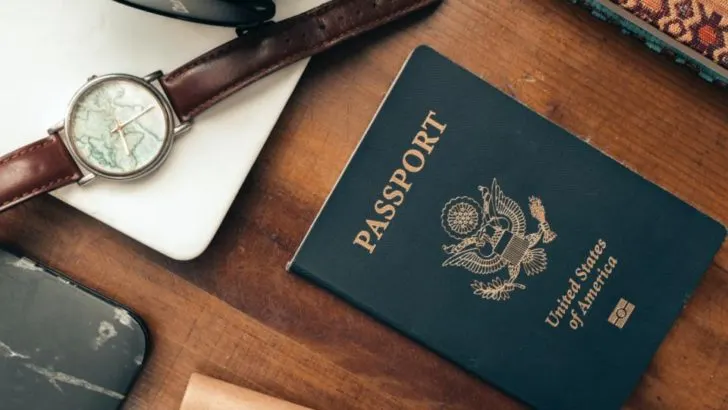
You don’t need a visa when traveling to Thailand if your stay is under 30 days in duration. Although, you will need to show that you have a ticket out of the country within the 30-day window.
Travelers looking to stay in Thailand beyond the 30 days, must obtain a tourist visa. There are a few options to get a visa.
- You can apply for an e-visa, via the Thai E-Visa Website.
- Visit the Royal Thai Embassy
- Or visit United States Consulate, prior to arriving in Thailand.
The cost for a Thai Visa (for U.S. Citizens) is 2,000 baht ($57 USD).
Tourist visas are granted for 60 days in the country. There is the option to extend it one additional time for 30 days. The fee to extend your stay is 1,900 baht ($55 USD).
If you enter the country with intent to only stay 30 days, but later decide to extend your stay for an additional 30 days, you can visit the Thai Immigration Bureau office. Again, the fee to extend your stay is 1,900 baht ($55 USD).
Make sure your Passport is not set to expire within 6 months of traveling to Thailand.
Best Time to Visit Thailand
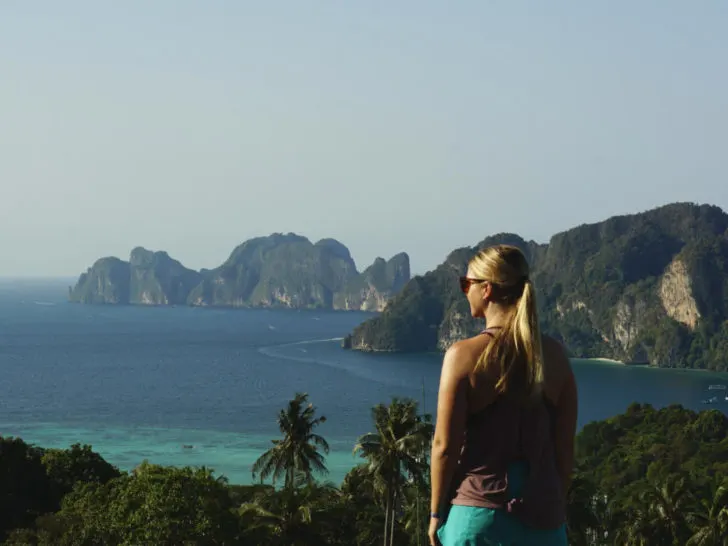
It’s best to visit Thailand in the dry season which is between November and early April.
But do note the temperatures don’t reach much higher than 90°F (32°C) making it relatively comfortable year-round. Although it can be very humid during the wet times of the year.
The rainy season or monsoon season in Thailand is typically between July and October.
The true answer to the best time to visit Thailand is whenever you get the chance. While there may be technically better times than others, Thailand is warm, and the rainy season still has nice sunny days mixed in.
Plus you can get better prices on tours, accommodation, etc in the non-peak season.
You Don’t Need To Know Thai When Traveling To Thailand, But It Can Be Good To Know Some Phrases
You really don’t have to know much of the Thai language when traveling to Thailand. But knowing a few phrases can certainly help. And we think it’s a fun language to speak.
Whenever we said a Thai phrase it almost always put a smile on a Thai person’s face. They really seemed to enjoy a tourist taking the time to learn a little bit about their culture.
The Thai language has its own alphabet. So without learning their alphabet, you won’t be able to sound out words.
But luckily the Thai language is relatively easy to pronounce for English speakers. (They also put English on most signs, menus, etc).
Here are a few Thai phrases that most tourists should learn. (We like to copy them as a little cheat sheet on our phones)
Probably the most important (and unique) piece of the Thai language is that most phrases or sentences end with khrup or kha. Khrup is added at the end if you are a male, and Kha is added if you are female. This is how polite-ness is conveyed in the Thai language.
For example, hello is pronounced Sa-wat-dee. And because I am female, I would say Sawatee Kha anytime I want to greet anyone. The Kha is also drug out, such as khhhhaaaa. You will notice this the first time a female Thai person greets you.
Here are a few helpful Thai phrases:
- Hello – Sawatdee
- Thank You – Cob Coon
- Bathroom – Hong Nahm
- Water – Nahm
- Money – Tang
- How Much – Thao rye
- Yes- Chai
- No – Mai-Chai
- Check please – Chek Been
- Not spicy – Mai ao pet
The Thai language is a tonal language, so the inflection of your voice is important for proper communication. Luckily, many Thai people who deal with tourists are accustomed to some common mispronunciations.
The best way to learn the tone is just by speaking the language and having a Thai person speak it back to you! Or another great way is to put the phrase into Google Translate and it will often spit out the proper pronunciation of the word or phrase.
Also remember that since Thai has a different alphabet, there really is no right or wrong way to spell Thai words with the Latin (A-Z) alphabet. Any spelling that helps you remember how to pronounce things is fine.
Download Google Translate for Offline Use
It can be super helpful to download the Thai language on Google Translate for offline use before traveling.
When traveling abroad, sometimes your phone plan might not work right away, or you need to get an e-sim card. So it can be super helpful to have a way to communicate with Thai-speaking people.
Many of the Thai people who work in tourism know enough English to communicate. But when someone doesn’t speak enough English or if you need to explain something in deeper detail, it’s very helpful to use Google Translate to communicate.
It’s common for Thai people to have Google Translate installed on their phones too. So they use it sometimes to communicate back.
Burn Season or Pollution
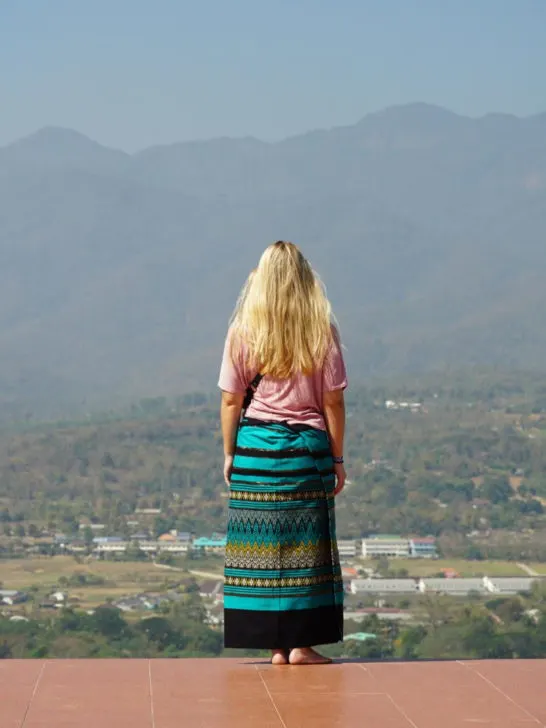
Southeast Asia has a “Burn Season”. This is when many of the farmers will burn the remaining old crops on the farm to start fresh in spring. Which in turn can cause smoke and haziness in the air. Burn season in Thailand is typically in late winter, starting in February and ending in April.
Burn season causes more air pollution, which can be hard for people with respiratory issues.
You will often see many people wearing masks because of the air pollution.
We visited Thailand in February and there was heavy pollution in the air (especially in the north).
In the southern part of the country, there are fewer farms and the land is much skinnier with both shores bordering the Gulf of Thailand and the Andaman Sea. Therefore, we didn’t experience nearly as much pollution or haze in the southern part of Thailand.
Exchange Cash With Your Bank Before Traveling
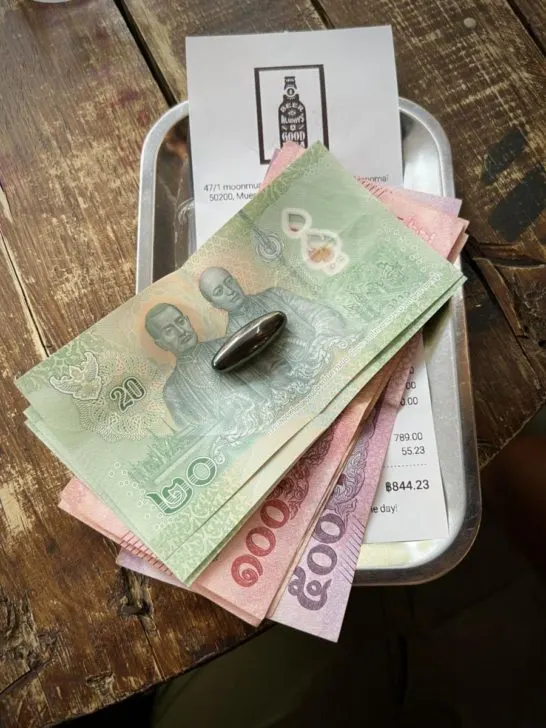
It’s best to exchange cash with your local bank before traveling to Thailand. While there are ATMs at the airports, they will often have a bad exchange rate.
The local currency in Thailand is called the Thai Baht (or Baht for short). One U.S. Dollar is equivalent to around 34.66 THB (as of August 2023).
Many ATMs in Thailand have a daily withdrawal limit. Typically the limit is around ฿20,000 ($617 USD). There are a few local banks that will allow a withdrawal of ฿32,000($925).
And considering that you pay a flat rate fee at most ATMs, it’s in your best interest to take out larger amounts at once.
Having a little bit of the local currency can help upon arrival, especially for getting a taxi to your hotel, grabbing some food, etc. While many countries will accept USD, they won’t always have change for you in the same currency. And essentially, might screw you over in the transaction.
So for peace of mind, and hopefully getting a good exchange rate, we suggest grabbing some Thai Baht from your local bank before traveling.
Depending on the duration of your trip, you can get away with just a few hundred to start and just visit a local ATM for more cash along your trip. (Especially once you know what a good exchange rate is, you can shop around a little more to find a good exchange rate).
“Choose Local Currency” When Taking Money Out Of An ATM Or When Paying With Credit Card
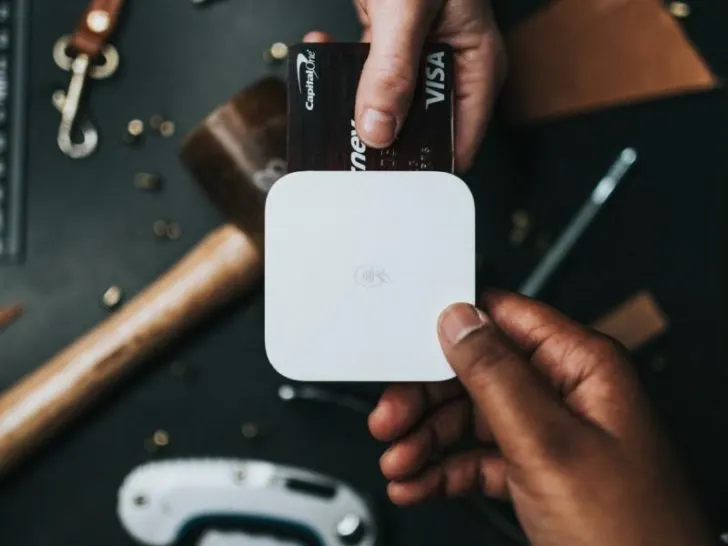
When withdrawing money from an ATM or making payments at local establishments using your credit card, you might encounter the option to select between paying in the local currency or your own currency (such as USD in my case). It’s always advisable to opt for the local currency.
This leaves the exchange rate up to your home bank versus the bank of the ATM. Opting for your home currency could lead to the local bank determining the exchange rate and possibly applying a higher rate that benefits them.
Opting for “charge me in the local currency” allows your home bank to set the exchange rate, typically adhering to the standard exchange rate. However, this recommendation assumes that you have confidence in your home bank’s practices.
Find A Bank With No Foreign Transaction Fees
If you anticipate using your credit or debit card frequently while on your journeys, it can prove advantageous to be affiliated with a bank that doesn’t charge foreign transaction fees. Or even one that offers reimbursement for any such fees you might incur.
Here is a list of 15 great checking accounts that don’t charge a foreign transaction fee or at least have a minimal fee. Additionally, here are 9 of the best credit cards that don’t charge a foreign transaction fee.
Adding an E-sim on Your Current Cellular Plan
During our overseas trip to Thailand, we faced some uncertainty regarding the optimal phone plan to select. Our cellular service provider, Verizon, offers an International Travel Plan that we found excessively costly given its benefits – coming in at $100 per month or $10 per day.
Individually, we recognized that conventional phone calls and texts were unnecessary for data use, as we could rely on Wi-Fi for such communication with friends and family. Our main concern was having access to data while not connected to Wi-Fi, which proved invaluable when navigating the streets, booking taxis, or looking up information online.
For those whose phones are compatible with e-sim technology, we think it’s more convenient than using physical sim cards. Modern phones boast dual sim capabilities, allowing you to retain your regular phone plan for Wi-Fi usage and utilize a separate sim or e-sim for international data needs.
Here is our guide for using esim cards.
Maya E-Sim
We opted for Maya Mobile e-sim, which enabled us to harness the power of local cell towers while continuing to use our existing phones. The service offers the flexibility to select either the specific country you’re traveling to or a broader region (like Asia/Pacific).
One of the standout advantages of Maya Mobile is its carrier-agnostic nature. It seamlessly connects to the carrier offering the strongest signal in your vicinity.
Maya Mobile has a range of data options, including 1GB, 3GB, 5GB, 10GB, and unlimited data, with ranges from 7 days to 30 days. Using travel e-sim with your phone is a straightforward process, making it your go-to data source when Wi-Fi isn’t available.
However, it’s worth noting that before buying a large amount of data on an e-sim, there’s plenty of free Wi-Fi in hotels, eateries, shops, and various establishments (more details provided below).
Wifi is Everywhere (but it kinda sucks!)
Luckily, there is wifi in most public places in Thailand, but don’t expect high-speed internet.
Free wifi is so available that it might be possible to travel in Thailand without a local cellular data plan. You can often just use wifi from local shops/hotels to look things up or to help get around the city. The only place this might not be feasible is in much more rural areas where there isn’t an abundance of local shops or similar.
We had heard rumors that the internet was fast in Southeast Asia, but we honestly didn’t really experience this much. Most of our hotels had slow but still “workable” internet. But it usually wasn’t fast enough for video streaming or other higher data uses. Which sometimes was a detriment for us working remotely on this blog.
Don’t Drink The Tap Water
Sadly, tap water in Thailand is not safe to drink.
Therefore, you have to buy bottled water. Most hotels will provide a new bottle of water daily, but you obviously drink more than this. So you will often need to stock up at local convenience stores or buy water at restaurants.
It does become a bit of a chore to make sure you always have enough water to drink. But our water consumption is pretty high, about 65oz per day (≈ 2 liters).
Apparently, you can boil the tap water to make it safe for drinking, but I wouldn’t solely depend on this method. You can always boil water and then pair it with a Larq Bottle which kills 99.999% of harmful bacteria found in water.
It’s Safe To Drink The Ice In Thailand
Restaurants outsource their ice. So the ice that is used in drinks is usually from a factory that uses filtered water. You can always ask for your drink with no ice just to be safe. Or stick to bottled or canned drinks that are sealed.
Can You Brush Your Teeth With The Tap Water in Thailand?
While many people brush their teeth and wash their face with the tap water in Thailand with no problems, you might want to be extra cautious to not swallow any water. If you usually rinse your mouth out with water after brushing, maybe use filtered water for that instead.
If you are at all worried, definitely just use bottled water rather than risk it!
We brushed our teeth with the tap water for a month of traveling in Thailand and never had any problems.
Stock Up On Tums and Imodium
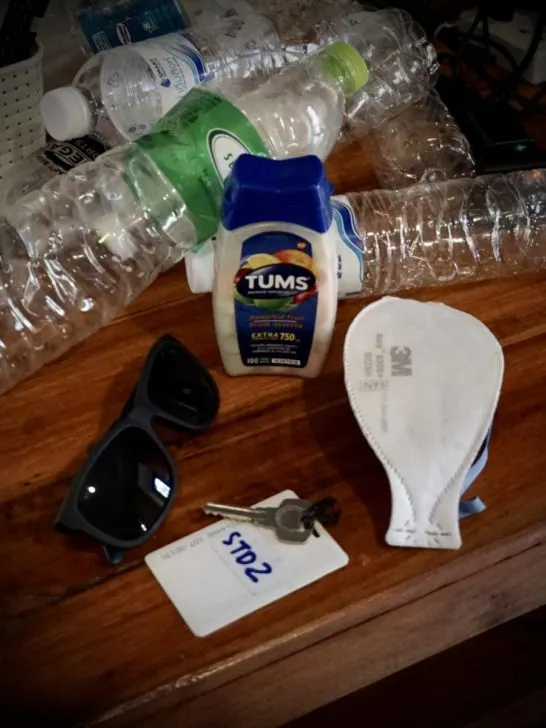
With the above info, this leads me to my next piece of advice when traveling to Thailand. Stock up on Tums and Imodium. We found it challenging to find some of these products over there. And often it might be called something different or in Thai.
And unless you have a stomach of gold, you will likely experience a couple of stomach…. “episodes” along your trip.
And just because you can handle the spicy food going in doesn’t mean you can handle it coming out. (Jake learned this lesson the hard way, many times actually)
People often refer to stomach issues as “Bali Belly” or “Traveler’s Diarrhea”.
How To Respectfully Visit Buddhist Temples
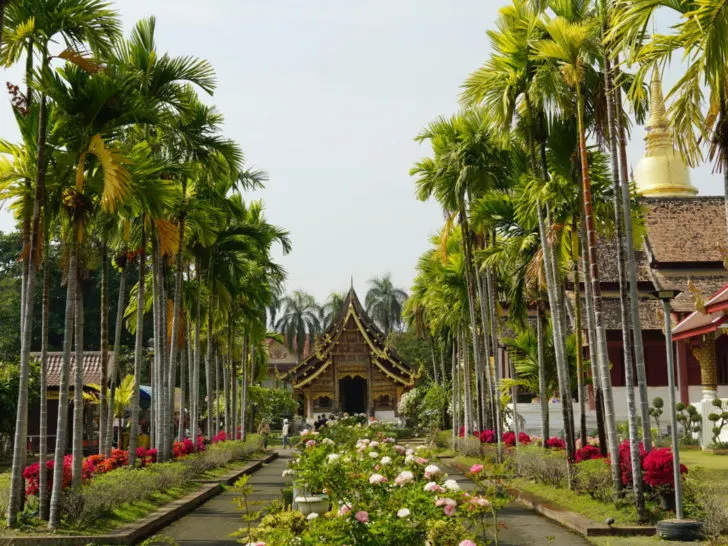
Temples are sacred places of worship in Thailand. There are a set of rules one must follow when entering temples.
You must cover your shoulders and often need to have something covering your legs or at least down past your knees. This tends to be easier for men because they wear T-shirts and longer shorts. Therefore, women will often carry a scarf or shawl for covering their shoulders or to wrap around their waist.
This is typically why you will see many people in those “flowy linen pants” so they can cover their legs without sweating to death in the hot temperatures.
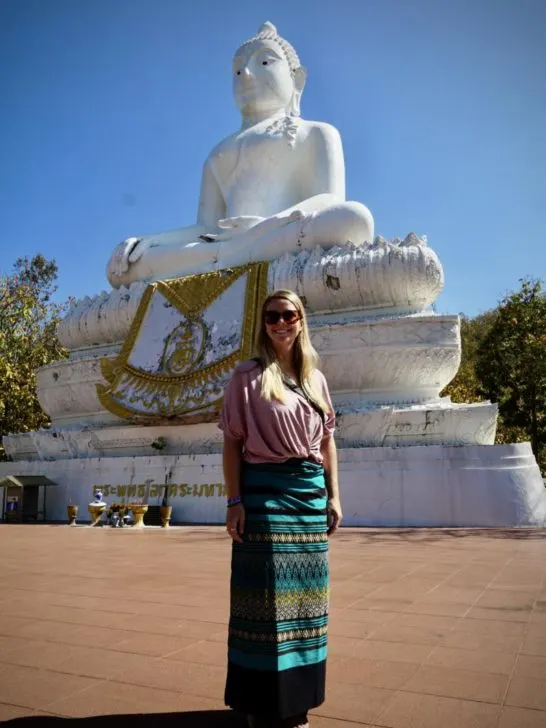
There are often people renting or selling clothes outside popular temples for a small fee or donation.
It is also required to take off your shoes before entering a temple. You will often notice the shoes piled up alongside the stairs before entering into each temple. It’s also respectful to remove any hats and sunglasses.
Also, don’t touch, point at, or stand taller than a Buddha statue. It’s also respectful to not point your feet at a Buddha (which we personally found challenging walking into a temple). Use common sense, if you have to ask if something is allowed or not, then you should probably not do it. For example, no eating, smoking, or drinking inside a temple.
If you encounter a monk, it is polite to bow as a sign of respect. There are often the stated rules outside the popular temples, therefore give them a quick read and make sure you are entering the temple respectfully.
Lastly, it’s disrespectful to buy a Buddha as a souvenir. This goes for Buddha images, Buddha statues, tattoos of a Buddha, any clothing with a Buddha, etc.
Show Respect To The Royal Family
This should come as common sense, but it is a criminal offense to disrespect the royal family in Thailand. It’s probably best to not even talk about the king and his family at all.
Don’t Touch A Thai Person’s Head
I think this one should also fall under the common sense category, but it still might need to be said to some people. The head is very respected in Thai culture, therefore it is found very disrespectful to touch a Thai person’s head. (Probably should stick to this rule anywhere you travel)!
Elephant Tourism
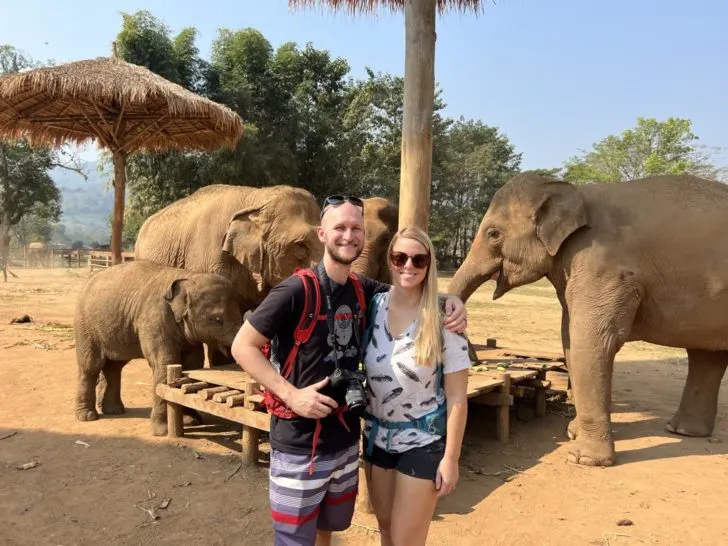
Seeing Elephants up close is an almost unbelievable experience that should be on everyone’s Thailand Itinerary. But you must be very careful when choosing an ethical Elephant tourism experience.
Sadly there is a dark side of elephant tourism. For too long these majestic animals have been tortured and made submissive to the whims of passing tourists.
And one of the best ways to combat this is knowledge. Some people simply don’t know what they are supporting. So hopefully through awareness, we can stop the flow of money to these animal abusers.
People sign up for a tour or see a fun sign for elephant riding or taking pictures with elephants and assume it’s a harmless activity.
But there are still many places mistreating these animals, breaking their spirit from a young age, keeping them in chains, and forcing them to “perform” until their breaking point. And all just for human pleasure.
So just make sure you do your research if you ever visit a place offering animal tourism. Giving your tourism dollars to the right people provides funds to help rescue and care for more elephants.
Elephant Nature Park
The place we visited was Elephant Nature Park about an hour north of Chiang Mai. They are one of the most well-respected elephant sanctuaries in the world.
They have taken in over 100 elephants into their care, many of whom are physically injured and/or socially damaged from a life of torture. But here at Elephant Nature Park, they are given a better life.
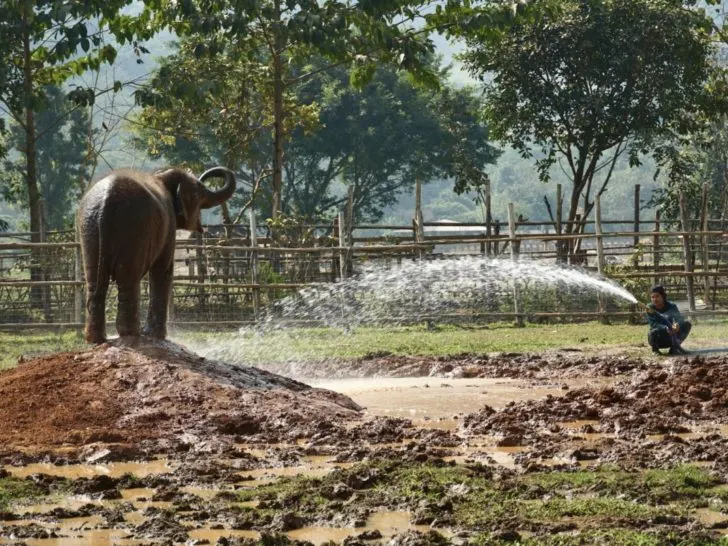
The elephants here are given open range of the property, forming social groups, playing in the mud, and cooling off in the river. None of which is catered towards human visitors.
Many of the elephants have problems from a life of torture and neglect for their well-being. It’s quite heartbreaking to see elephants with broken hips/ankles, an inability to socialize with other elephants, blindness, tumors, and other ailments.
But that makes your heart melt when seeing the elephants enjoying their new better life here.
The blind elephants make friends who help guide them around the property. The baby elephants find foster parents willing and able to nurture them. It’s really sooo heartwarming.
Nothing about the elephants’ behavior is forced for the visitors’ enjoyment. You simply get to enjoy observing the elephants live normally. There literally not “gated” in and are free to roam off into the wild. But they enjoy their area and feel safe there.
You can sense their intelligence through their personalities and emotions; joy, curiosity, jealousy, compassion, ohh, and HUNGER. Have you ever seen an animal put an entire watermelon in its mouth?
You can take your picture with a few exceptionally friendly elephants, but it’s very much on their terms.
There are some other humane elephant experiences in Thailand, but just be sure to research and ask questions, even if it’s something offered by a tour operator.
Just hoping to spread more awareness and guide fellow tourists into the right tours. We feel this is one of the most important things to know before traveling to Thailand.
Bring Ziplock Bags
The advice we got from another travel blogger before traveling to Southeast Asia was to pack a handful of zip-lock baggies. They either do not exist in Asia or if they do, they certainly make them hard to find.
Undoubtedly, this is an underrated travel recommendation. It proves useful for purposes like storing food, safeguarding valuables from moisture during wet hikes, or serving numerous other functions.
Lantern Festivals
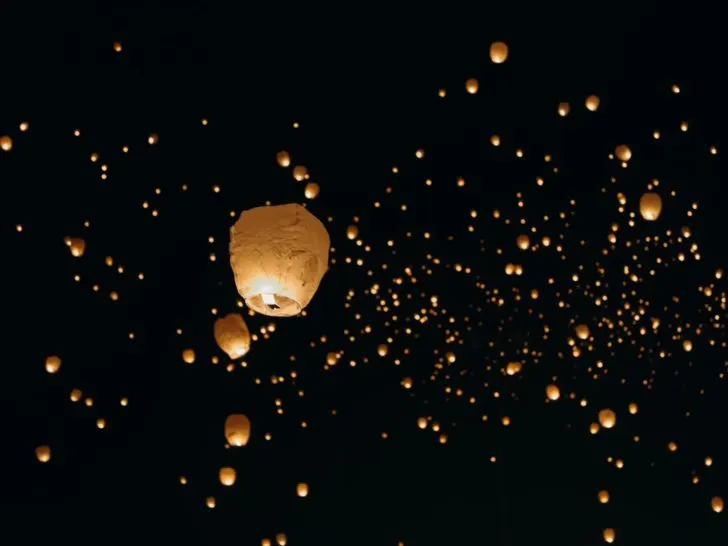
Photo by Leon Contreras on Unsplash
There are two main lantern festivals in Thailand: Yi Peng Festival and Loi Krathong. If your travel dates are wide open, these two festivals are things to know before traveling to Thailand and possible reasons to plan your trip around.
Ti Peng Festival is celebrated on the full moon in the second month of the Lanna (the ancient northern Thai kingdom) lunar calendar.
Loi Krathong occurs on the evening of the full moon during the twelfth month of the Thai lunar calendar.
Sadly, we weren’t here during either of those dates, but if you can plan your travel around one of these festivals, I’m sure it would be a magical experience.
Songkran Festival (Water Festival)
One of the most famous festivals in Thailand is the Songkran Festival. It takes place in April every year, from the 13th to the 15th.
Basically, people go around throwing water at each other. It’s a fun festival to help beat the heat!
Whether it be a bucket, water gun, water balloon, etc. So definitely expect to get wet and maybe use one of the ziplock bags we mention bringing in this post to put any valuables you don’t want to get wet.
Download the Grab App
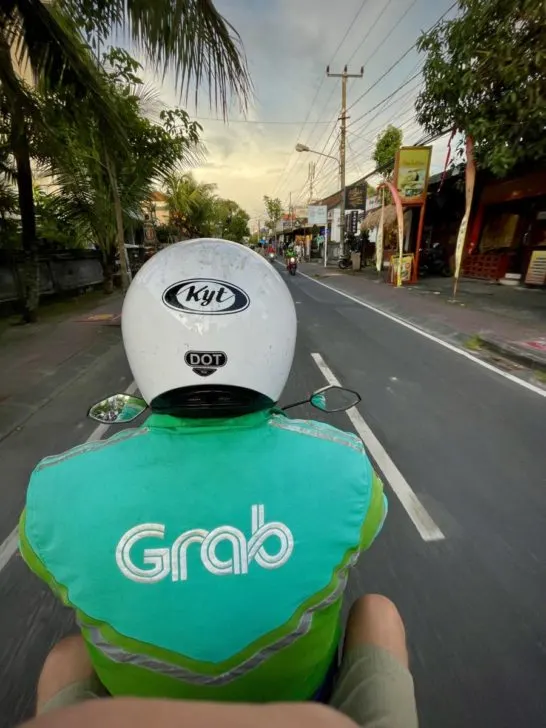
“Grab” is Southeast Asia’s ride-share app. It is the equivalent of Uber or Lyft in America.
You can book rides or also get food delivered via the app. And it is SUPER affordable most of the time! Like way cheaper than taxis.
On our first night in Chiang Mai, Thailand we decided to just order some food in. We got a Panang Curry, Massaman Curry, and fried spring rolls, for less than $8 USD (including delivery fee, tax, and tip).
However, just like in other countries, drivers are sometimes not available in more rural areas.
Tuk Tuks & Songthaews
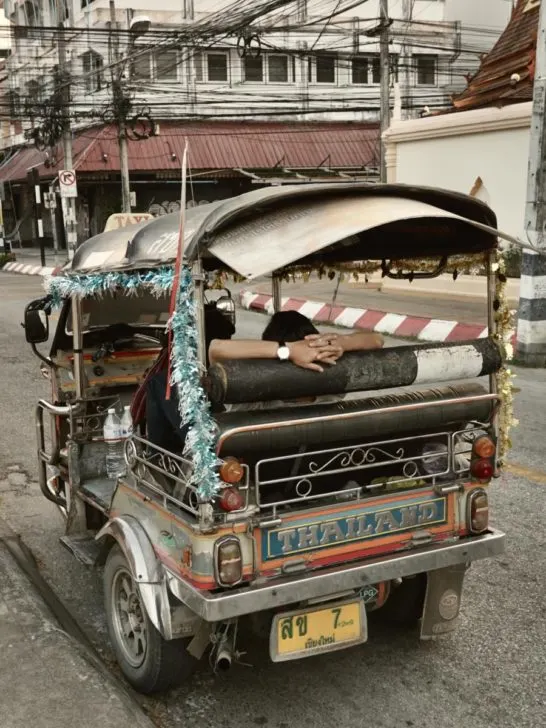
A popular mode of transportation in Thailand is via a tuk-tuk. These are small little 3-wheeled trucks that drive around the city. Personally, they don’t seem very safe because there are no seat belts, and really nothing protecting you if you are to get in an accident.
But with that being said, it is an affordable and fun way to get around the city. So take a tuk-tuk at your own risk!
You will often find tuk-tuk drivers on the side of the road in many popular touristy areas.
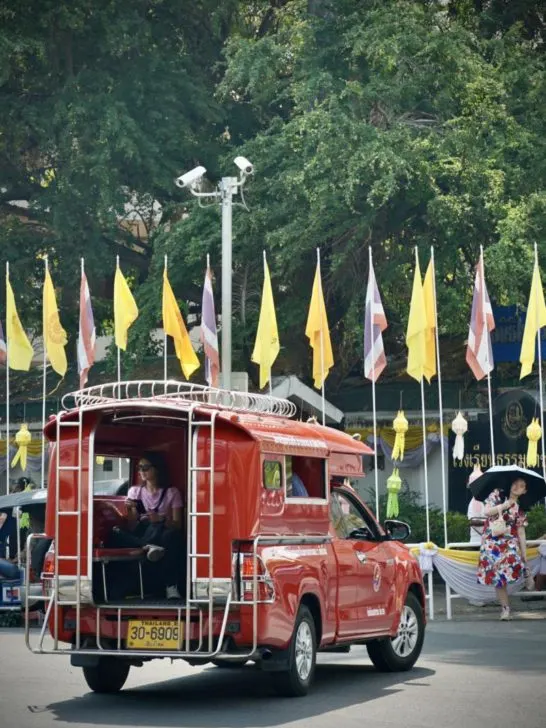
There are also Songthaews in most popular cities and towns. These are red (or yellow) pickup trucks that have bench seats in the back. It’s another affordable way to get around but again doesn’t feel that safe. Oh and car exhaust seems to circulate into the passenger area.
Grab Versus Taxi
There are safety reasons why using Grab might be better than getting a taxi. And that is because all the drivers go through a background check and driving history check. Additionally, when you book a grab ride, your phone’s GPS tracks where you are.
And because there might be a language barrier, it was kinda nice to just put in your final address and trust you would make it to the right spot.
Plus it was almost always cheaper to take a Grab than get a taxi. The only downside is you might have to wait a few minutes for your ride to show up, versus a taxi driver being there and ready to drive you straight away.
Longtail Boats Are A Common Transportation
Longtail boats are a very common type of water transportation in Southern Thailand. These long narrow boats are practically an iconic symbol of Thailand.
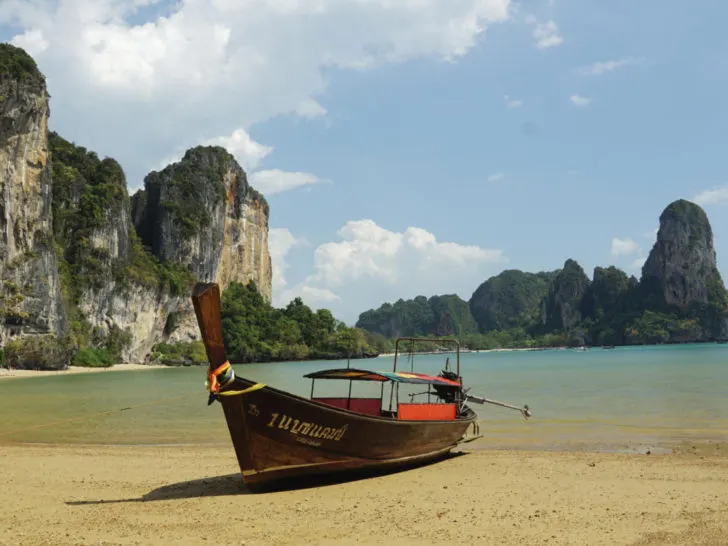
If you are traveling between islands or coastal destinations hiring a longtail boat is a great way to get around. Or sometimes it’s the only way to get there, like the famous Railay Beach near Krabi.
Longtail boats have an outboard motor that sits right on the stern (back) of the boat. Because of this, it can be very loud riding on a longtail boat. We recommend having some earplugs to make the rides more pleasant (and they are also great for getting better sleep at night.)
It’s Cheap To Travel Domestically In Thailand
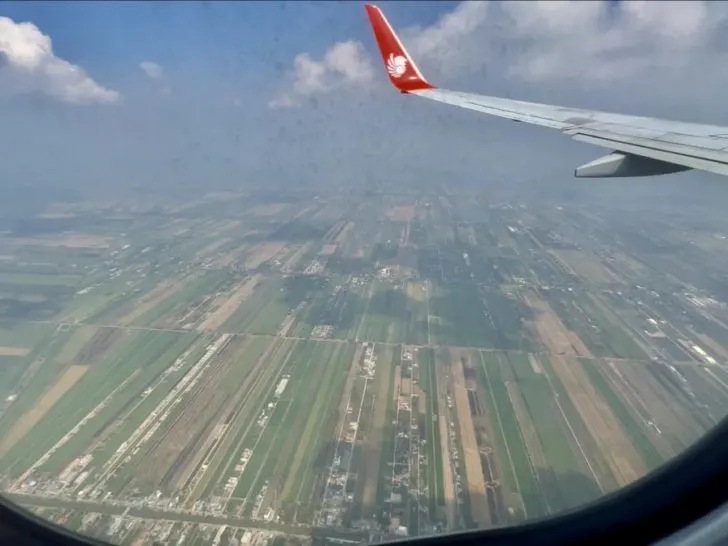
Domestic travel is way cheaper than flights to get to and from the country. You can often find domestic flights from Northern Thailand to Southern Thailand (specifically Chiang Mai to Bangkok) for as little as $11 one way.
So don’t rule out flights for getting around Thailand.
The same goes for train and bus travel to and from cities. Some bus tickets can be just a couple of dollars. We used the website 12goAsia to find cheap travel around Thailand.
You Might Not Need A Travel Adapter
We thought travel adapters were a necessity when traveling to Thailand, but we never once needed one.
The standard outlet they use actually functions as an adapter, accepting several different types of common plugs.
All our hotels, hostels, restaurants, trains, etc always had a Plug Type A (which is the 2-prong plug we use in the USA). But with that being said, I’d still bring one, just in case!
IMPORTANT!! It’s crucial to note that if you possess any Type B plugs (those with 3 prongs), a travel adapter is imperative. This often applies to non-Macbook laptops.
We brought along three travel adapters, anticipating frequent use, but they ended up occupying precious space in our luggage due to their relatively bulky nature.
Travel adapters can still prove advantageous as a makeshift power hub. Given that several accommodations had limited outlets, we utilized our travel adapters to simultaneously charge multiple devices using a single outlet.
When selecting a travel adapter, consider your power requirements and the specific outlet types you need, such as USB-A, USB-C, etc. Generally, the greater your power demands, the higher the cost of the adapter.
Devices like laptops and drone batteries can draw substantial power. However, it’s typically feasible to plug these devices into outlets with the standard power supply.
Travel adapters come in lots of configurations, but the one we like best is this travel adapter. It has a good mix of USB-C and USB-A, with one USB-C port capable of passing 35 Watts.
If you want a really powerful charger that can charge a laptop, this expensive Epicka Travel Adapter can pass up to 75 watts. Which would be enough to charge a large MacBook Pro allowing you to leave that annoying bulky Apple brick at home.
This is a good value Travel Adapter with plenty of ports for smaller devices.
And lastly, here’s a good Travel Adapter with mostly USB-A ports (which are quickly becoming obsolete).
Do You Need A Voltage Converter When Traveling to Thailand
Similar to travel adapters, you might want to consider carrying a voltage converter. In the United States, the standard supply voltage is 120V, whereas in Thailand, it’s 230V.
Assess the supported voltage specifications of your devices to determine their compatibility. For instance, my Apple Macbook charger specifies support for 100-240V, ensuring it functions seamlessly in both the U.S. and Thailand without needing a voltage converter.
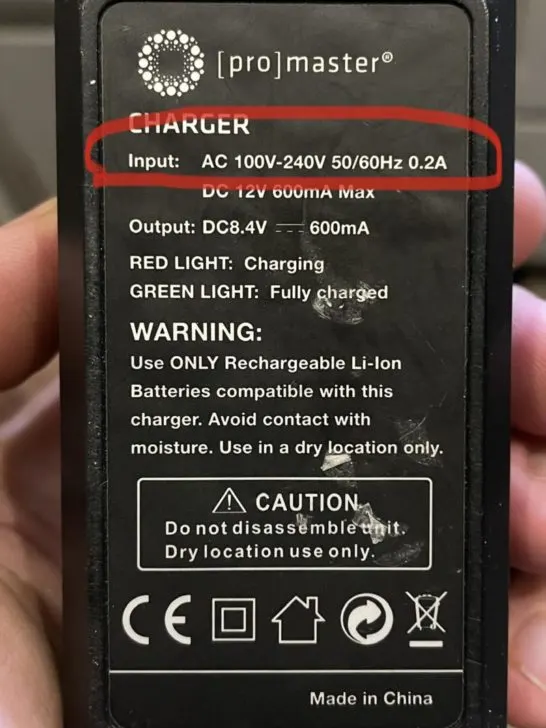
Your primary concern should be devices that generate heat, like hair straighteners, irons, and electric kettles.
(Note that minor voltage differences are not a concern. For instance, 110 volts and 120 volts are usually interchangeable, similarly to 220 volts and 230 volts)
Virtually all electronic devices indicate their accepted voltage range on the power supply. Prior to packing any electronic items, scan the fine print on the power cord or adapter. This information will likely detail the range of acceptable voltages.
We found that almost all of our electronic devices could support 230V charging. (Cell phones, computers, cameras, headphones, etc).
However, my Braun Electric Toothbrush Charger is designed to work within the 110-130V range. Consequently, if I were to connect it to an outlet in Thailand, there’s a high likelihood that it would become damaged and rendered unusable (effectively turning into waste). This item would need a voltage converter to safely charge from a Thai outlet.
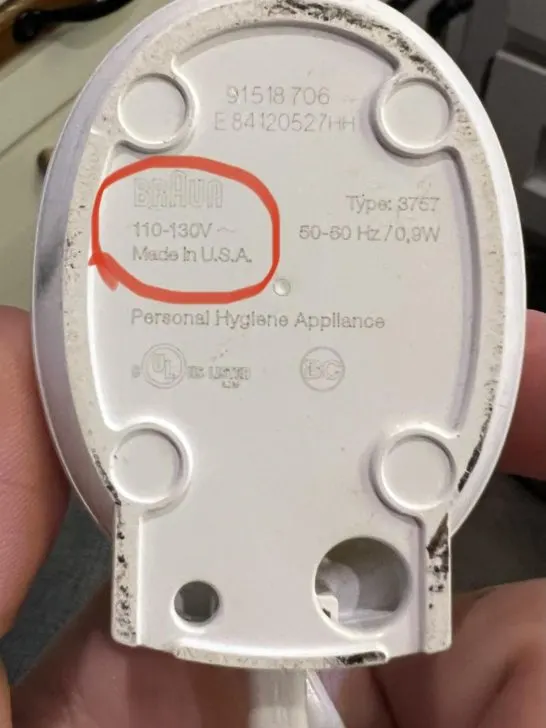
We decided that it was cheaper and easier to just buy a 230-Volt version of our toothbrush charger, rather than buying a bulky voltage converter just for one device. And an even easier solution would be to just use a non-powered toothbrush for the time being.
Hence, there’s a possibility that all your chargers could be compatible with a 230-volt power supply. It’s advisable to thoroughly verify this before your trip. Otherwise, having a voltage converter might be precisely what’s required to ensure your devices are adequately powered and safeguarded against potential damage.
From our standpoint, it’s generally more practical to find alternatives to items that require voltage converters.
Bathrooms in Thailand – Bring TP (remote places don’t have any)
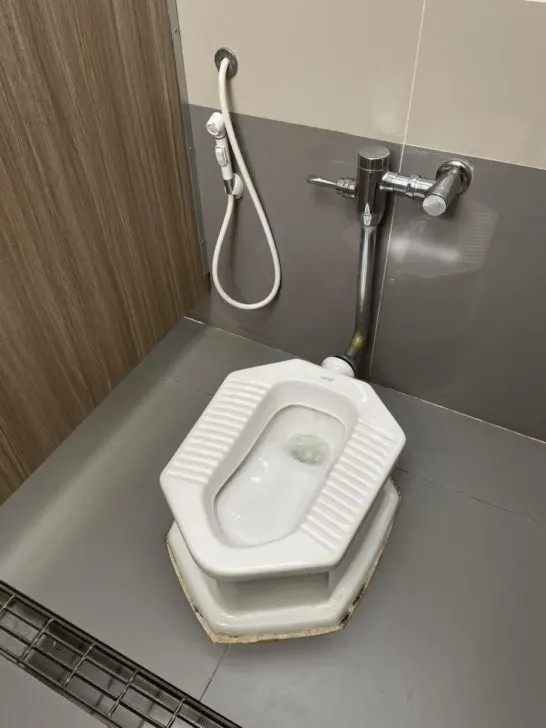
Toilet facilities in Thailand can differ significantly from conventional toilets in the United States. While most hotels typically feature standard seated toilets, it’s common to encounter squat toilets instead of the familiar “Westernized” models.
Many of the squat toilets just have a large bucket of water with an additional small bucket with a handle to “flush” the waste. Ultimately making the bathrooms very wet!
Also, several rest stops and bus stations charge a nominal fee for restroom usage. Strangely, I noticed that these paid facilities often appeared the most unclean and neglected, which was annoying given the fee. And you sometimes had to pay extra or at least ask for TP.
Always Pack Toilet Paper
Toilet paper might not always be provided in public restrooms, instead, you may find a spray hose for cleansing purposes.
To be candid, Jake and I never quite grasped the utility of the hose, though it seems to be a widely embraced practice in Thai culture. It serves as their version of a bidet, but it’s a far cry from the sophisticated and user-friendly bidets found in French or Japanese bathrooms.
In Thailand, their bidet consists of a simple hose and sprayer affixed to the wall. I personally found it slightly uncomfortable that this hose, after being used for intimate cleansing, is handled by everyone and then reattached to the wall.
Unlike the practice in the U.S., toilet paper cannot be flushed down the toilet. All paper products, including toilet paper, must be disposed of in the provided trash receptacle. Yes, this even applies to toilet paper used for #2.
Many public restrooms might not offer toilet paper at all. I always carried a small zip-lock baggie containing toilet paper when using public facilities. You might also consider carrying a tiny bottle of soap or hand sanitizer also, as this was often not prevalent in the bathrooms.
We became accustomed to requesting extra rolls of toilet paper when checking into hotels, as they typically didn’t provide an ample supply to align with our American toilet paper habits.
Restaurant Service Is Different From The U.S.
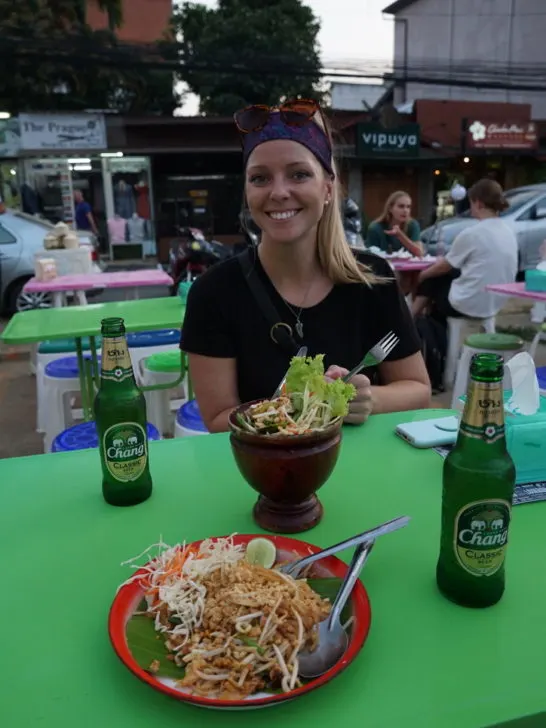
The service provided at restaurants is done slightly different than in the U.S.
Typically when going out to eat in the U.S. you visit the host/hostess, he/she seats you at a table. Then a server comes to you and takes your order.
In Thailand, there are usually no hosts, but upon arrival, someone tends to acknowledge you are looking for a table and will help guide you to a spot.
Then, they will likely bring you menus. If you wait for a few minutes and no one brings you menus, then you will likely just need to ask for some.
If a server acknowledges that you sat, then they will likely come back to grab your order. But it is common to need to just catch eye contact, or yell Excuse me – (Khor tord Khrup/Ka).
In Thailand, you can call out to a server at any time really, just if they are reasonably close enough to hear you.
Servers often don’t check on you during meal service, so if you do need something you will need to get their attention.
Westernized Food On Menu (But…not that good)
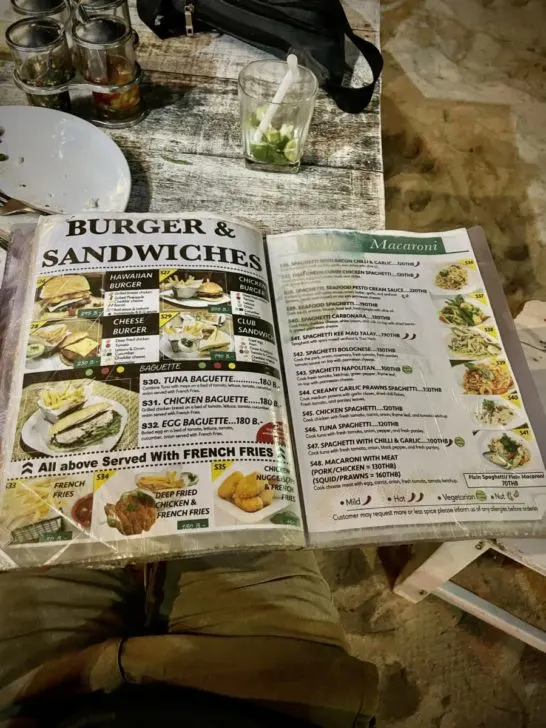
The menus in Thailand were always massive and had just about every item. It was common to see a sign with the name of the restaurant and then it proceeded to list every type of cuisine “pasta, American, pizza, seafood, Thai, etc”.
You would see carbonara, pizza, and hamburgers on just about every menu no matter the type of cuisine they were serving. And there was often no description of what to expect.
For example, if you ordered carbonara, it might come with hot dogs as the protein instead of traditional bacon or pancetta pieces. Or you would order a club sandwich and think it might come with mayo, lettuce, tomato, lunch meats, bacon, cheese, etc. But it would have an egg, a slice of ham, and not much else. We would often try and ask what would come on certain items, but the servers didn’t always know. So it was sometimes a complete gamble on what would appear at the table.
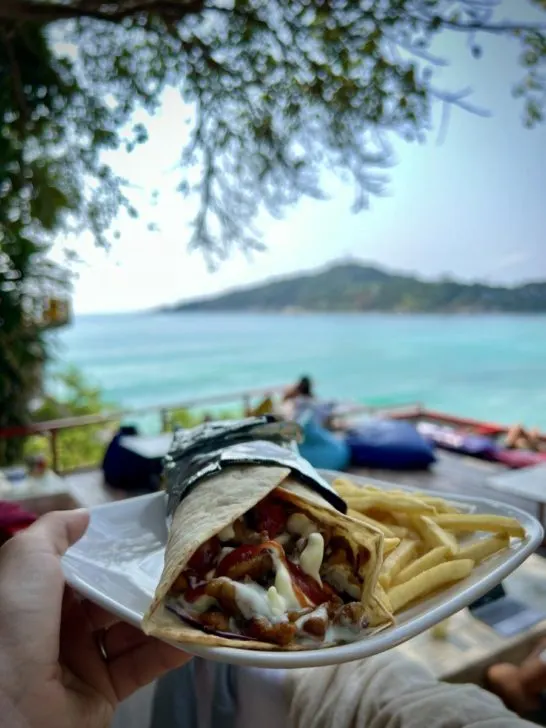
(But really it’s just chicken with ketchup and mayo in a wrap with mediocre fries)
We visited Thailand second after being in Vietnam for a month. So by now, we were craving some Westernized food. And every time we would order a Westernized cuisine, it really didn’t live up to the standard in the U.S.
So if you can help it, just order Thai or the specific cuisine of the restaurant you are visiting.
Two must-try dishes in Thailand are Panang Curry and Khao Soi! But do remember the phrases Mai ao pet (Not Spicy) and Mai ao prik (Not spicy at all).
Thailand Doesn’t Use Chopsticks
It’s pretty common for Asian countries to use chopsticks, but Thailand actually just uses forks and spoons. It’s not common to have a knife at the table, but most things can just be broken off with a fork.
Tipping Isn’t Customary
One of the most appealing aspects of dining out in Thailand is that tipping isn’t an established practice. Although gratuities are certainly appreciated, they are seen as a supplementary gesture for the server, unlike in the U.S. where tips significantly contribute to their overall earnings.
It’s worth noting that in certain Southeast Asian countries, tipping is gaining some traction. While not customary, a server or taxi driver might anticipate a small additional amount if they perceive you as a foreigner.
In such situations, it’s wise to rely on your judgment. If someone assists you or delivers exceptional service, there’s no harm in brightening their day by offering a little extra cash as a token of appreciation.
Watch Out For Monkeys

The monkeys have gotten accustomed to tourists coming around every day and they are not shy. While they might be cute, they are still wild animals and can carry rabies.
Monkeys aren’t afraid to grab your bag, sunglasses, water bottle, etc. And once they do, there is really not much you can do about getting it back. Because they will likely just show you their sharp teeth and run off.
Therefore, always secure any loose items and keep your bag close to you. Trust me, they can be sneaky!
No Vaccines Required (But you might consider a few before traveling)
There is no requirement for certain vaccinations before traveling to Thailand. But some common vaccines people get before traveling are Tetanus, Hepatitis A, and now Covid-19.
Some other vaccines that are optional are typhoid, cholera, yellow fever, Japanese encephalitis, rabies, etc.
Consult your doctor for the proper vaccines before traveling to Southeast Asia.
Hotel Pictures Can Be Misleading
Occasionally, the images of hotels you encounter on booking websites can present them as exceptionally lavish. However, these photographs often capture the establishments when they were freshly built and in impeccable condition.
While they weren’t outright horrid, there were instances where we encountered mold in the bathrooms, wall blemishes, torn wallpaper, absent furnishings or decorations, and the occasional air conditioner that had clearly exceeded its cleaning schedule.
It’s worth mentioning that our selections were mostly budget-oriented, favoring the most affordable options that still held positive reviews. This might differ if you opt for more upscale accommodations.
Our most valuable advice is to thoroughly read recent reviews to gain an accurate understanding of what you’ll actually receive. Travelers often provide candid feedback to offer insights for those who follow. It’s common for booking websites to show you the highest rating (which can be from years ago), so make sure to filter to recent reviews.
Additionally, the impact of COVID-19 has certainly affected hotel renovations and updates, so it’s prudent to factor this into your considerations, especially when establishments might require some refurbishment and maintenance.
Pack Less!
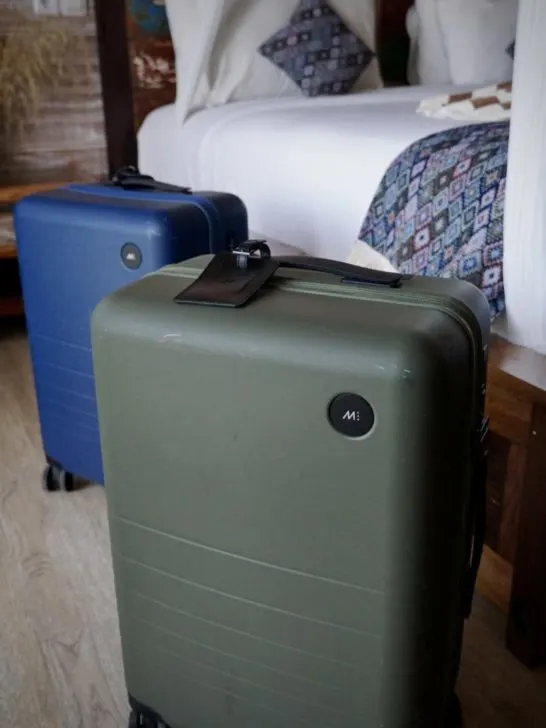
On a couple of occasions, we faced challenges due to the weight of our carry-on suitcases. For our travel, each of us opted for the Monos Carry-on Plus along with a small backpack. This combination afforded us sufficient space to travel extensively across varying climates for a continuous three-month period.
However, our choice often exceeded the size and weight limits specified by many Southeast Asian airlines. Consequently, we had to either check our bags (despite them fitting into the overhead compartments) or, in a few instances, discreetly maneuver our bags during the check-in process.
Notably, the weight limit for certain budget airlines in Thailand could be as low as 15 lbs (7kg), often including the collective weight of both the carry-on and personal items or sometimes allowing just a single carry-on bag.
This was very different from our experiences on North American flights where carry-on weight restrictions are seldom a concern.
We encountered a situation where we booked separate flights with two different airlines to save a couple hundred dollars.
In this scenario, we were compelled to carry on our bags; otherwise, we would have been required to exit the airport, retrieve our baggage from the claim area, and subsequently re-check it with the other airline (potentially leading to missed flights). Fortunately, the check-in attendant displayed empathy and permitted us to carry on the slightly overweight bag.
All things considered, anticipate the likelihood of having to check your carry-on or make diligent efforts to maintain a minimal weight.
Add An AirTag To Your Luggage
Consider attaching an AirTag to your carry-on, especially if you foresee needing to check it.
Adding a tag can offer peace of mind, not only at airports but also when you leave your bag in your hotel room.
The Monos bag proved advantageous to us due to its locking mechanism, particularly in instances where a safe wasn’t available in the room. Knowing we could secure our belongings in our suitcase assured they were safe when staff entered the room for housekeeping purposes.
Ultimately, if you pack lighter from the start of your trip, you might have space for a few mementos along your journey!
7-11 Is Everywhere!
7-11 is a convenience store that you can find just about anywhere in Thailand. This is likely where you will get your snacks, water, beer, toiletries, etc.
And on the extra hot days, 7-11 will be a godsend because the A.C. is always flowing.
Of course, there are other little markets in the city you can also visit.
Full Moon Party
One of the most popular events in Southern Thailand is the Full Moon Parties. It originated on the island of Ko Pha-ngan on Haad Rin Beach. Every month there is a huge full-moon party on the beach with loud music, neon colors, and dancing.
If you don’t like partying and loud music, you will likely want to avoid the south shore of Ko Pha-ngan altogether. Or avoid the time building up to the full moon and partially after.
Because the party has become so popular, you will likely find some smaller half-moon parties as well.
Possession of Illegal Drugs May Lead To A Hefty Fine Or Even The Death Penalty
If you are found in possession of illegal drugs, you might be found in prison with the death penalty. Thailand is NOT the place to mess around with drugs (obviously nowhere is! but most places don’t have the death penalty as punishment).
While Thailand did just pass the law for medicinal marijuana, recreational use is still illegal. You can learn more about illegal drug use in Thailand, here.
That being said, marijuana and mushrooms are widely available in many touristy areas. And their presence is not subtle either.
But to be on the safe side, you can always get a nice buzz from local Chang beer!
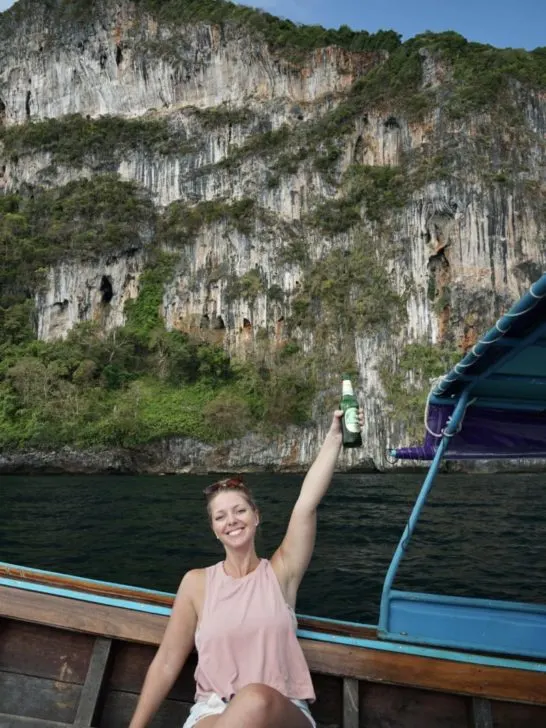
Be Cautious of Street Food
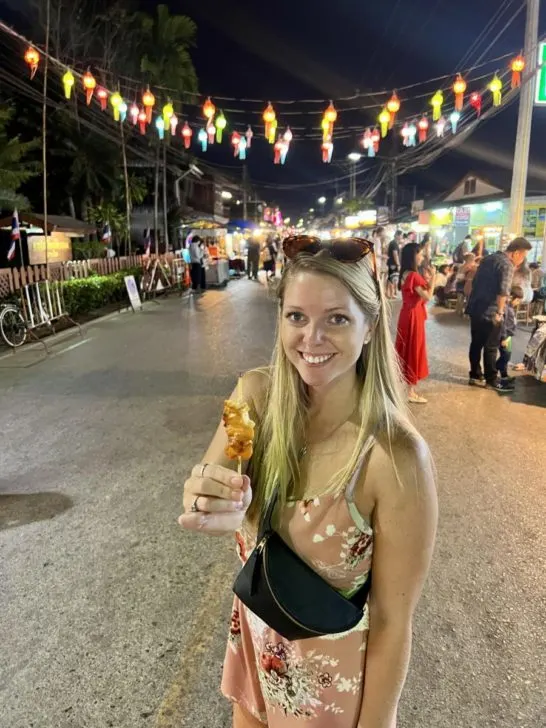
Cleanliness is not exactly Southeast Asia’s strong suit. They don’t have the same food safety standards that developed countries have.
There isn’t soap in many of the restrooms… So that makes us think they are not really using something to kill the bacteria on their hands.
Many restaurants in buildings, probably have a sink and soap to wash hands, dishes, etc.
But street food vendors who don’t have their own kitchen for preparing and cooking their food, are likely just using the public restroom for hand washing.
While I’m not suggesting skipping street vendors entirely, just use common sense and be a bit more cautious about maybe exposing yourself to food-borne illnesses. Choose vendors that are popular. It’s a good rule of thumb if you see a Thai person in the line, it’s probably a quality vendor.
Get Travel Insurance Before Traveling to Thailand
If you are a U.S. Citizen, then your health and auto insurance will likely not extend to traveling abroad. So it is best to be prepared with travel insurance.
We personally recommend SafetyWing for your travel insurance because it’s designed with digital nomads in mind. Their affordable plans offer global health coverage, trip interruption protection, and the flexibility to suit your ever-changing lifestyle. Knowing you’re covered no matter where you are lets you focus more on enjoying your travels and less on what-ifs.
World Nomads and Allianz are two other popular travel insurance companies.
World Nomads and SafetyWing will cover more extreme activities. Such as skydiving, trekking, getting bit by a monkey, etc (definitely read the fine print for more details). Because they cover the more extreme activities it will be a bit more expensive.
Allianz is the travel insurance we have. They cover more of the typical issues you might run into. Such as scratches on your rental car, breaking an ankle on a city walking tour, getting a virus and needing medication, etc.
Because we were traveling for multiple months we chose an annual plan. But you can also choose a plan for a shorter duration.
Of course, there are tons of other travel insurance companies to choose from.
Shopping Is Way Different In Thailand
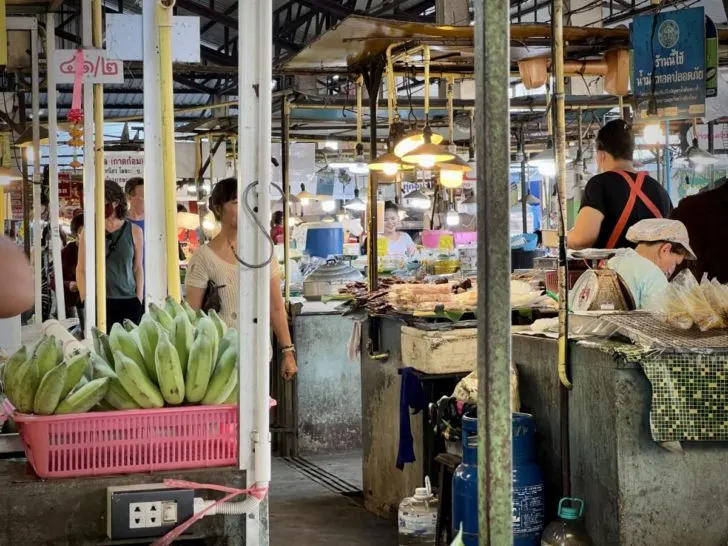
Unlike the United States, where expansive department stores offer a comprehensive array of products under one roof, Thailand follows a different pattern. In the country, such all-in-one stores are not the norm.
While some major cities might have grocery stores, reaching them might not be as straightforward. These establishments are primarily oriented toward tourists and do not mirror local shopping practices.
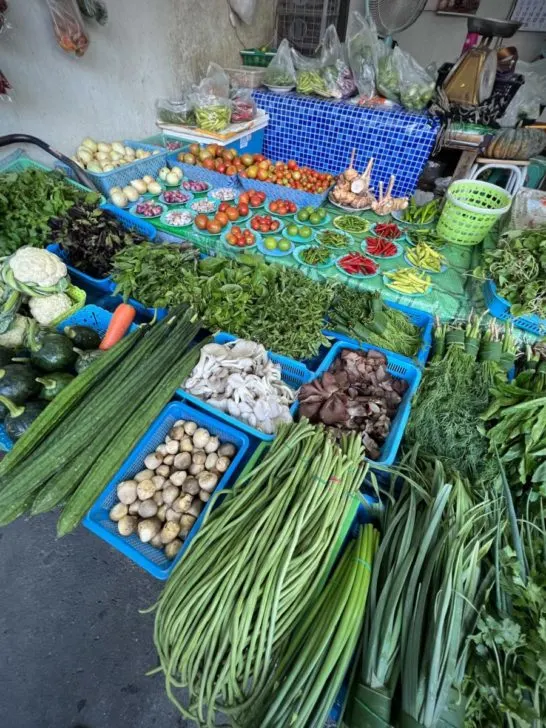
Should you need groceries, your best bet lies in exploring the local markets dispersed throughout the city or seeking out vendors who travel on motorbikes, offering produce and snacks.
Toiletries can often be found at small convenience stores around the city.
Sunscreen Is Different
The sunscreen in Southeast Asia is different from the brands we are used to in the U.S. We tried a couple different brands and one was super thick and pasty (like seriously impossible to fully rub into your skin). And another one being what seemed “watered down”. After a full day in the sun, we would notice a splotchy tan/burn.
We suggest bringing as much sunscreen as you can if it fits into your suitcase. You might be able to find some Westernized sunscreens in the major cities, but they will likely cost a pretty penny. But honestly, it might be worth it!
Also, be sure to make sure the sunscreen you are buying or bringing is Reef-Safe.
Tampons Can Be Challenging To Find
For female travelers, locating tampons in Thailand can prove to be somewhat challenging. While pads are more readily available, tampons are not as commonly found.
To ensure preparedness for your extended journey, I recommend either packing an ample supply of tampons or exploring the option of using a menstrual cup as an alternative.
You Might Want To Think Twice About Renting A Motorbike In The Big Cities
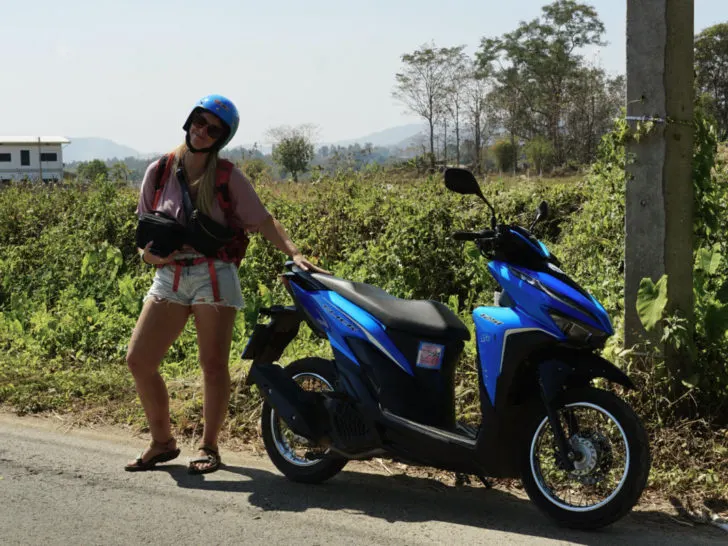
Motorbikes are an integral part of life in Thailand. However, a significant cultural adjustment for us was the traffic and driving situation. Sadly, Thailand makes it near the top of the list, as the 9th country with the highest road traffic death rates.
The stereotype of the saying “Asians are bad drivers” might gain new perspective when you witness the local driving norms. It’s quite an experience, to say the least!
Personally, we found the traffic in Thailand to be more well-managed than in Vietnam. There were more stop lights, and people adhering to the traffic control signs.
Ultimately, if you decide to rent a motorbike, be sure to rent a helmet, and stay very aware on the road. We felt much safer in small towns and rural areas, rather than busy cities.
Takeaway | Things To Know Before Traveling To Thailand
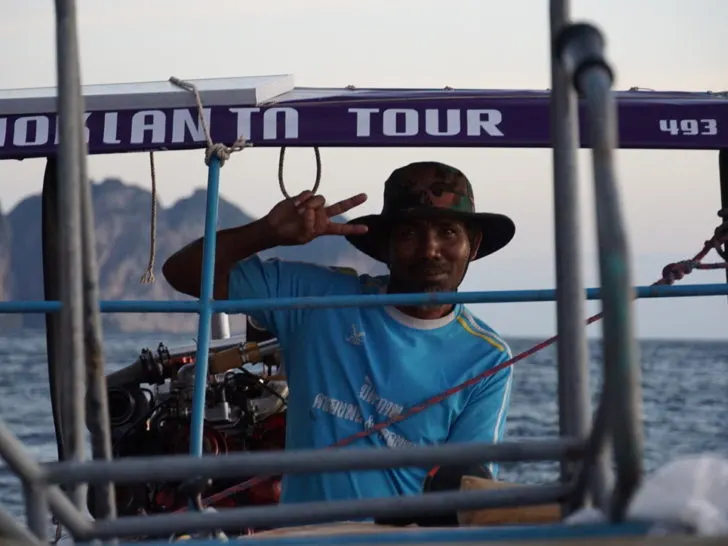
Embarking on a journey to Thailand is a remarkable adventure that promises unforgettable experiences. Armed with insights and preparedness, you’re well-equipped to navigate the nuances of this captivating country.
From cultural norms to practical tips, you’re now primed to make the most of your time in Thailand. Embrace the vibrant street markets, indulge in delectable cuisine, explore ancient temples, and connect with the warm-hearted locals.
These helpful things to know before traveling to Thailand are personally what I wish I knew before traveling to the country.
As you immerse yourself in Thailand’s rich tapestry of history, landscapes, and traditions, remember that every step you take will be a stride toward a cherished and transformative journey. Safe travels!
Save These ’48 Things To Know Before Traveling To Thailand’ For Later
